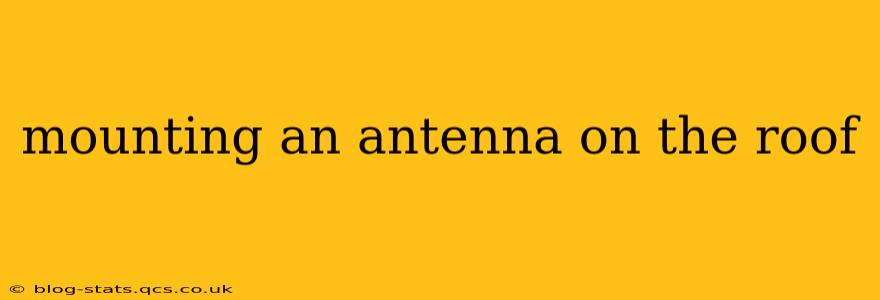Mounting an antenna on your roof can significantly improve your TV reception or expand your Wi-Fi range. However, it's a project that requires careful planning and execution to ensure safety and effectiveness. This comprehensive guide will walk you through the entire process, addressing common concerns and offering expert advice.
Choosing the Right Antenna and Location
Before even thinking about mounting, you need the right antenna. The type of antenna you need depends on several factors:
- Signal Strength: Are you in a rural area with weak signals, or closer to a broadcast tower? A high-gain antenna might be necessary in rural areas, while a lower-gain antenna might suffice closer to the towers.
- Frequency: Different antennas are designed for different frequency bands (UHF, VHF). You'll need an antenna compatible with the frequencies your local channels broadcast on.
- Antenna Type: Consider options like Yagi antennas (directional, high-gain), omni-directional antennas (receive signals from all directions), or flat panel antennas (aesthetically pleasing but potentially with lower gain).
The location is just as crucial. Ideal placement maximizes signal reception while minimizing interference:
- High and Clear: The higher the antenna, the better the reception, generally speaking. Make sure there are no obstructions like trees, buildings, or hills between your antenna and the broadcast towers.
- Orientation: Directional antennas need to be pointed towards the broadcast towers. Use a compass and online resources (like TV Fool) to determine the optimal direction.
What Tools and Materials Will I Need?
The specific tools and materials will vary based on the antenna type and your roof's construction, but generally, you'll need:
- Antenna: The specific antenna chosen based on your needs and location.
- Mounting Mast: A mast provides the necessary height for optimal signal reception. The material and length will depend on your chosen antenna and roof.
- Mounting Hardware: This includes bolts, screws, nuts, washers, and potentially brackets or straps, depending on your antenna and roof type. Choose weather-resistant materials like stainless steel.
- Roofing sealant: To waterproof the holes you drill.
- Ladder: A sturdy ladder that extends safely above your roofline. Consider using a ladder stabilizer for extra security.
- Drill with appropriate drill bits: You'll need bits capable of drilling through your roofing material.
- Level: Essential for ensuring the antenna is mounted straight.
- Wrench and Screwdriver: Appropriate for the mounting hardware.
- Safety Gear: This is paramount! Always wear safety glasses, work gloves, and sturdy footwear. A safety harness is highly recommended if working at significant heights.
How Do I Safely Mount the Antenna?
Safety is the top priority. Never work alone, especially on a roof. Always have a spotter to assist you. Here's a step-by-step guide:
- Plan your mounting point: Identify a suitable location on your roof that meets the criteria mentioned above. Consider the proximity to electrical wiring and chimneys.
- Secure the mounting mast: Attach the mast securely to the roof using appropriate mounting hardware and sealant. Ensure it's plumb and stable.
- Mount the antenna: Attach the antenna to the mast, following the manufacturer's instructions. Again, ensure it's securely fastened and level.
- Seal all holes: Carefully seal all holes drilled into your roof with roofing sealant to prevent leaks.
- Ground the antenna: Proper grounding is crucial for safety, especially during thunderstorms. Connect the antenna to a grounding rod using a ground wire. Consult a qualified electrician if unsure about grounding procedures.
- Test the signal: After installation, test your signal to ensure the antenna is working correctly.
What are the potential risks associated with mounting an antenna on my roof?
Rooftop work is inherently dangerous. Potential risks include falls, electrocution (if working near power lines), and injuries from falling tools. Always prioritize safety and consider professional installation if you are uncomfortable working at heights.
Can I hire someone to mount my antenna for me?
Yes, you can hire a professional antenna installer. This is often the safest and most efficient option, especially if you lack experience or are uncomfortable working at heights.
What kind of permits do I need to install a roof antenna?
Permits may be required depending on your location and the specifics of your installation (e.g., HOA regulations, local building codes). Check with your local authorities before starting the project.
This guide provides a comprehensive overview of mounting an antenna on your roof. Remember to prioritize safety throughout the entire process and don't hesitate to seek professional assistance if needed. By following these steps and taking necessary precautions, you can enjoy improved signal reception for years to come.
